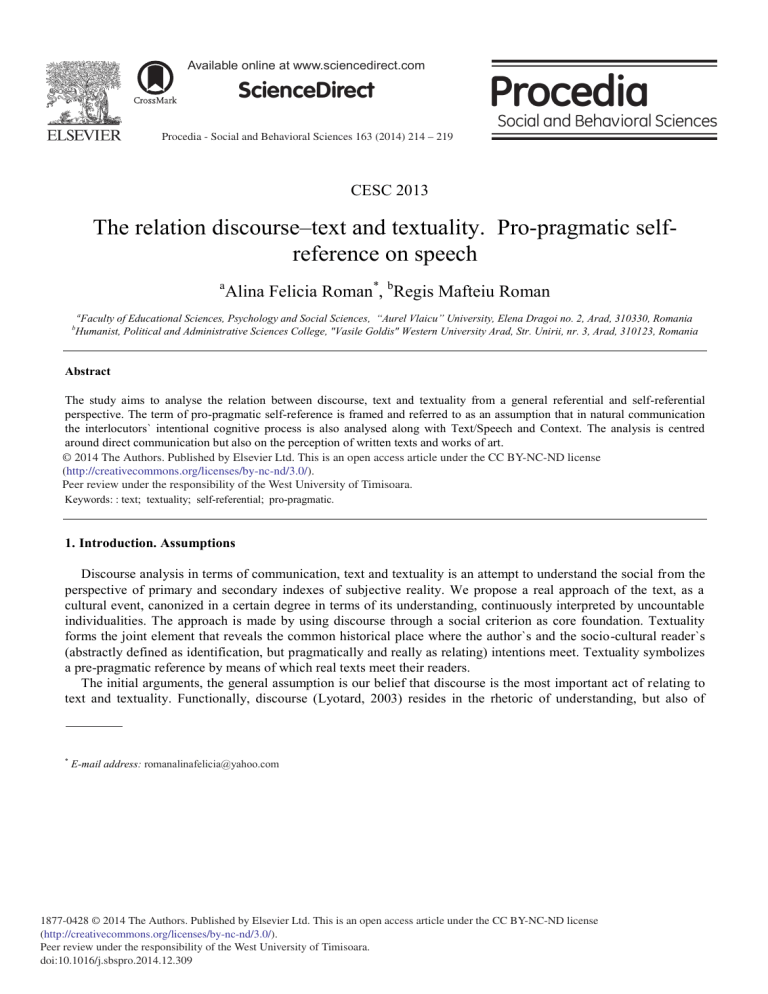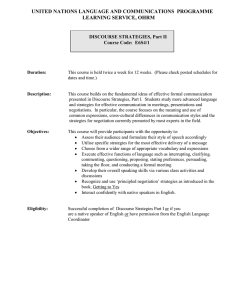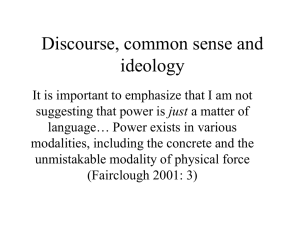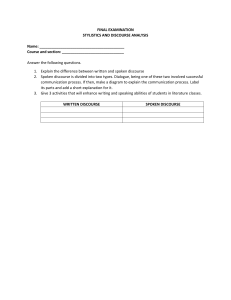Discourse, Text, and Textuality: Pro-Pragmatic Self-Reference
advertisement

Available online at www.sciencedirect.com ScienceDirect Procedia - Social and Behavioral Sciences 163 (2014) 214 – 219 CESC 2013 The relation discourse–text and textuality. Pro-pragmatic selfreference on speech a Alina Felicia Roman*, bRegis Mafteiu Roman a Faculty of Educational Sciences, Psychology and Social Sciences, “Aurel Vlaicu” University, Elena Dragoi no. 2, Arad, 310330, Romania Humanist, Political and Administrative Sciences College, "Vasile Goldis" Western University Arad, Str. Unirii, nr. 3, Arad, 310123, Romania b Abstract The study aims to analyse the relation between discourse, text and textuality from a general referential and self-referential perspective. The term of pro-pragmatic self-reference is framed and referred to as an assumption that in natural communication the interlocutors` intentional cognitive process is also analysed along with Text/Speech and Context. The analysis is centred around direct communication but also on the perception of written texts and works of art. ©2014 2014The TheAuthors. Authors.Published PublishedbybyElsevier ElsevierLtd. Ltd. © This is an open access article under the CC BY-NC-ND license (http://creativecommons.org/licenses/by-nc-nd/3.0/). Peer review under the responsibility of the West University of Timisoara. Peer review under the responsibility of the West University of Timisoara. Keywords: : text; textuality; self-referential; pro-pragmatic. 1. Introduction. Assumptions Discourse analysis in terms of communication, text and textuality is an attempt to understand the social from the perspective of primary and secondary indexes of subjective reality. We propose a real approach of the text, as a cultural event, canonized in a certain degree in terms of its understanding, continuously interpreted by uncountable individualities. The approach is made by using discourse through a social criterion as core foundation. Textuality forms the joint element that reveals the common historical place where the author`s and the socio-cultural reader`s (abstractly defined as identification, but pragmatically and really as relating) intentions meet. Textuality symbolizes a pre-pragmatic reference by means of which real texts meet their readers. The initial arguments, the general assumption is our belief that discourse is the most important act of relating to text and textuality. Functionally, discourse (Lyotard, 2003) resides in the rhetoric of understanding, but also of * E-mail address: romanalinafelicia@yahoo.com 1877-0428 © 2014 The Authors. Published by Elsevier Ltd. This is an open access article under the CC BY-NC-ND license (http://creativecommons.org/licenses/by-nc-nd/3.0/). Peer review under the responsibility of the West University of Timisoara. doi:10.1016/j.sbspro.2014.12.309 Alina Felicia Roman and Regis Mafteiu Roman / Procedia - Social and Behavioral Sciences 163 (2014) 214 – 219 215 relational interpretation without being absolutely at all times replicable in the same contextual, civilizational and cultural conditions. Discourse is a continuous comment that does not lead to answers in spite of the interlocutors` inexhaustible clauses and judgements. The rhetoric of discourse makes reference to text and textuality; to message and actual directional interpretation. And the actual carries two methodological senses from a semiologic (Saussure, 1998) point of view. It is synchronic and immutable at the level of text occurrence but also diachronic and mutable at the level of understanding its significance. Specific assumptions are: SA 1: the study of a texts` reference is directly related to the study of textual selfreference, to the way in which speech is founded on symbolic communication; SA2:a text`s self-reference can be identified best in the pre-pragmatic plan, which we define as the interlocutors` intentional process. By means of presented judgements I came to highlight certain issues that are involved in the social reception of a text. No text is completely immutable, since an author suggests it to the other and no socio-cultural reception is fully mutable. The existing paradox is a result of a process of continuous formation in terms of sense and word significance (Ricoeur, 1995). The relating process is obvious: the author is not able to retain each term that occurs in the text under the form of a function, although the work s/he releases for the public is quite closed and words constantly change their meaning and significance, without becoming incomprehensible. This process is much more with textual translations. It results in the emergence of initial syntactic-semiotic corruption of terms, notions and the pre-pragmatic understanding of words is naturally multiplied by the reader`s understanding. The consequences can be efficacious or not, because they form of a different reality from the one experimented by the initial text. Simplifying, the reader of the text is not able to discover through a linear expression, the original, identical structure of the text because of speech mutability, of its constant evolution but also because of self-referential and intentional formative premises: creation maintains the relative certainty of speech understanding. To synthesize, in order to bring the text closer to the reader, one has to discover a pre-pragmatic competence that would identify the range of intentionality used to decode both text and its further textuality. 2. General considerations: discourse, text, textuality Discourse is different from communication and conversation because relating statements grasp a social updated and contextualized rhetoric which is common for the locator that relates to the interlocutors. It changes into discourse, which is after all a definition of dialogue, the moment it becomes active, when interlocutors start to interact. The discourse turns into an authentic social discourse, if the dialogue can be replied by other interlocutors too. It is predefined and predetermined by culture and civilization and the interlocutors have a negligible role. All these situations are possible due to formative elements that are contained by the common buri of speech which is the text. What is the text? A text is a “relatively limited wholeness” (Starobinski, 1985). The conditions of understanding the text as an intensifying unit of each discourse are expressed. In this case, the text signifies a “vigorous object”, becoming the referee that cannot be eluded and the something that requires a “constant return” (Starobinski, 1985). The permanent return to the text through reading and re-reading makes reference to the infinity of a text`s interpretation (Peirce, 1990) on pragmatic and social level. The interpretation of a text as a mechanism of cognitive psychology, “actually means to arrange it so that its elements would find their place in a more general schema. Shortly, interpretation is the assimilation to a cognitive schema” (Miclea, 1994). By applying this criterion we understand that: works were regarded as the expression of a “literary genre” (Harvey, 2002) and had to be analysed according to a unique criterion, to a “universal code”. In postmodernity works are obviously seen as a “text” and can be analysed according to a relative, intertextual criterion, which leads to their inter-association with a rhetoric and a specific idiolect. Once modernity was overcome, significant new words appeared that would try to relation the text unity also by reconceptualising the speech functions. Gerard Genette (1992) used some notions for pedagogic purposes, highlighting the important role that the social has in understanding texts through: x Transtextuality was defined as the form of understanding a textual transcendence of a text, as a process of discovering everything that puts it in a (manifested or secret) relationship with other texts. Transtextuality reveals the subtextual functions that any text carries with itself. Transtextuality is singularized by some functional mechanisms that describe the subtextual nature: intertextuality, metatextuality and hipertextuality. 216 Alina Felicia Roman and Regis Mafteiu Roman / Procedia - Social and Behavioral Sciences 163 (2014) 214 – 219 x Intertextuality is a concept that describes a relationship of co-presence between at least two texts, by a text`s presence in the other. x Metatextuality is a comment that links one text to the other. x Hipertextuality expresses the relationship between two texts, one derived from the other (by transformation or imitation). But these notions rely on a modern prejudice that considers the text as inferential and the subtext cognoscible. In reality, texts are only described and in not in the least explained. At intentional level we can accept the relationship of co-presence between texts but it is reduced to associative analysis of social relationing and expresses nothing more. Reconceptualization is mere transpositions of logical reports between notions/terms which are not valid, only stated. We notice that the notions of: transtextuality, intertextuality, hipertextuality have a common denominator, a proximate genre that is explained by a relation between at least two texts. The man puts two texts in a dialogue-like relationship. A referential state is experimented by subjectivity: texts that designate something, coding a process in order to decode another. To complete the coding and decoding operation, the discourse, the dialogue and the social communication can be reduced to the study of speech units and the context of their usage. Thus, we would remain at the level of modern text interpretation. The need of understanding more than texts “say” on referential and contextual level and from hermeneutical, phenomenological, pragmatic and structural perspective, led to the search of a text`s hidden significance. In narrow sense, a text is a sequence of signs, superordinate to a clause with a varied thematic content. It is characterized by extensional and intensional semantic relations between clauses. In wide sense, the text and the discourse are considered unitary and complementary sides of a unique object “analysed by textual grammar from structural perspective (with emphasis on cohesion, coherence, connectors, etc.) and by discourse analysis from contextual perspective” (Rovenţa-Frumuşani, 2005). A text`s and a discourse`s unique object is speech unity as the science of communication and interpretive understanding. So far, we have explicitly described the simple forms of speech by reference to syntactic, semantic and pragmatic aspects. However, the last three levels have been referred to in order to be understood in a particular framework, namely contextual or on a generally formal field: linguistic or socio-culturally archetypal, anthropologic, etc. Besides the significance system (text, clause, discourse, symbol and direct or indirect communication) and the context of its usage, we also have to analyse the self-referential and pre-pragmatic premises of speech. 3. Synthetic schema of binary and tertiary cognitions on speech The unity of speech as communication science is perceived differently, according to predominant strategies of relating to criteria of judgement/texts/ clauses/ sentences control. Until the modern period, two cognitive poles were used which made the difference between right and wrong, useful and useless, efficacious and inefficacious. The understanding would become rigid and bipolar. General or absolute cognitive strategies were sought but they clashed the exceptions of referential representation – logical tokens, for instance. The premises of self-reference were mocked at in a pragmatic manner, being declared impossible to be found, as long as “there are no universal problems of interpretation, more likely, there are particular problems that can be solved with regular research techniques” (Habermas, 2000). These approaches have tried to be overcome by introducing in speech analysis an interpretation paradigm that would be the effect of: the relativity in the authority of logical positivism; the development of phenomenology, of philosophical hermeneutics and critical theory, of structuralism (anthropologic, linguistic and sociologic), of socio-biology and eco-biology, the beliefs in the ability to explain the universal traits of culture “rather by human nature than by the rational infrastructure of knowledge, action and human language, namely of culture itself” (Habermas, 2000). Consequently, modernity brought about saturated schemata on speech that were intended to be overcome. How? By getting semantics to a higher level of perception and understanding in what (meta)sensitive things are concerned. Hermeneutics approached the Greek techne but also the psychological form of interpretation along with Schleiermacher and Dilthey. The discourse analysis of spoken or written discourse had the overcome of misunderstandings as the main fundamental and self-referential assumption. Cognitive schemata of understanding Alina Felicia Roman and Regis Mafteiu Roman / Procedia - Social and Behavioral Sciences 163 (2014) 214 – 219 217 received an extra value that went beyond binary schematics: between acceptance and denial interfered the subjective-assessing or the contextual-objectivist. Habermas proposes not only linguistic (technical) competence to enable “understanding”, but also communicative competence. Relating, interaction and engagement in the speech act are targeted. The art of understanding is separated from the exposition of what is to be understood. All of them occurred as initial effect, since hermeneutics was thought out as a universal instrument of the spirit, (Codoban, 2001) by means of which interpretation seemed a trans-individual syntax (being grammatical and objective) which relates to exposition in a general linguistic framework, thus becoming also technical. Interpretation, to the extent to which it is also of social nature, seeks to discover individual usage of the language. Therefore, it is inserted in a field of community discourse of scientists or of natural discourse. The interpretation was mostly defined as identity and intropathy. By intropathy (Hügli, 2003) we understand re-experience, annealing of one`s spiritual life, an opportunity that can lead to empathy (Einfühlung) or to sympathy (Nachfühlen). Empathy is based on an impossible identity Ego-AlterEgo, and sympathy involves an assessing position achieved by discursive relation and interaction between Ego andAlterEgo (Boris, 2003). Operationally, the aim of the hermeneutical procedure is to find ways of understanding the author better than he understood himself, on the text level by a critical textuality, namely by a discursively of the lecture. The attitude of an interpretive behaviour is equidistant from other phenomena and procedures of epistemic or descriptive analysis of literary works. It applies mostly to those based on reproduction, repetition or reiteration methodologies. Critical textuality uses logical assumptions as means of discovering and understanding the meaning and the significance of any possible text, ignoring as much as possible, subtextual and contextual assumptions of a determined text. The essential actors are identified within the critical community of scientists (logicians and linguists). The lecture discourse involves the approach of paradigmatic requirements of a text from the perspective of natural language. The main actors are found within the social community of lecturers. Maybe that is why Heidegger, sceptically, excluded the idea of technical interpretation and understood comprehension as the foundation of any explanation. Heidegger used comprehension to self-awaken the Dasein (presence). Dasein as human existence schematizes „the feeling of having a place in the world” on the one hand and comprehension on the other. Only by discourse, by utterence (Rede) “being in the world” is revealed. Language is the essential disposition for the revelation of Dasein, and the ontological existential foundation is the discourse (Rede), the speech, the logos which placed on the same level with affection and understanding.Language is a discourse by two essential, intrinsic possibilities: by listening and silence. Listening is „constituent” (Hügli, 2003) to utterance and discourse. Heidegger points out that when we don`t hear something “well”, we say we don`t “understand” it. There is also the reductionist situation which he doesn`t experience, when we don`t understand because we don`t translate properly in our own being the meaning and significance of words. The transition from utterance to communication and discourse is made the moment the utterance is pronounced and the Dasein is routinely. Its opening is in the moment when through talks, curiosity and ambiguity one reaches the “reveal-status common to the Being-in the –world”. The discourse involves revealing because it takes part in the temporization of temporality. The discourse interiorizes time as a form of universality in the human sphere, as temporality and history. It engages man into a significant history by “contextualizing” comprehension and understanding his world as it is. Through discourse the human mode is depicted in its full transcendence. Ontological and ontic problems are a subtext of phenomenology. The uninvolved Dasein in its freedom is Husserl`s pure Ego. But both are static and unmovable, death because of potential freedom. Only when potencies and uncertainties seen as transition from ontological to ontic, as relation Ego-AlterEgo become actual, communication becomes possible. The belief according to which language is prejudice and ontos turns out fully justified. By actual, language precedes tradition and man. It is the source of potencies and of discourse as mediator in understanding hermeneutics, as revalue of an extensive rhetoric, as study of a text, as place where human subjectivity has to be overcome. On a phenomenology level discourse means unity between the world of science and the world of life. The world of life is an issue that has to be rediscovered and revalue. Because there is a unitary explanation of “European science crisis” and of “European humanity crises”, crisis can be overcome by crossing the barrier set by rationalism and positivism and adopting the idea of universal thinking. Subtextually, the actants of universal philosophy occur as diltheyan reinterpretation of analysing the relation subjectivity-intersubjectivity. Developed by interrelation, the phenomenological theory of intersubjectivity occurs as meeting between ego and alterego, between subjectivity and 218 Alina Felicia Roman and Regis Mafteiu Roman / Procedia - Social and Behavioral Sciences 163 (2014) 214 – 219 foreign subjectivity, between self and opposed self in subjectivism, between self-monad and inter-monad community. Husserl reaffirms that “each ego has its own history and it exists only as subject of a certain history, namely its own… History is the main fact of absolute being” (Husserl, 1994). It appears that the meaning of a text is not connected only to its structure as syntactic-semantic unit but also to the interpreter and his relationship with the text. The relation text-intertextuality (Călinescu, 2003) lies in the discovery of coherency in the relationship between subjectivity and intersubjectivity as form of comprising in the exposition as well as in the rhetoric and comprehensible interpretation of this co-present (intertext and intersubjectivity) presence (text and subjectivity). Gadamer succeeded to socialize the hermeneutical procedure, proposing an interpretive relation, which is placed on another level. A certain economy of the context is expressed and it is valued subtextually by the concept of social culture, manifested in tradition. If the model of the hermeneutical process is the dialogue (Gespräch), than text interpretation is: Gesprächmitdem Text, inter-locution, dialog with the text. The task of hermeneutics, said Gadamer, is to understand itself as a dialogue with the text. Outlining discursive understanding as ideal speech situation, as lack of exterior coercions in solving validity demands, Habermas pointed out that “the structure of communication does not bring about any coercion, then and only when all possible participants are given a symmetrical division of chances to choose and practice speech acts” (2000). An ideal rhetoric relation occurs: the opportunity to change roles in the dialogue, by chance equality on assuming certain roles in a dialogue, by performances of dialogue and by (undetermined) choice of speech acts. Transferred into natural speech, the ideal speech situation shows a defensive position of communication. It is the result of constant efforts to overcome misunderstandings. However, the solution found changes the speakers into exquisite rhetoricians. Lack of exterior coercions can be seen in a subtextual manner: either as possibility to adjourn communication (exchange of informations), or as possibility to misunderstand self-reference (lack of speech foundation). To synthesize, the relationship discourse, text and textuality was analysed until the Modern Age by referential perspectives and binary schemata. Along with the development of hermeneutics and with the attempt to overcome interpretation misunderstandings, researchers have tried to find besides linguistic and technical competences, also communicative and psychological competences. Along with what is visible and explicit, what is less visible and less explicit became also significant. There have occurred the pre-pragmatic assumptions of understanding the meaning and significance of a text, by discourse and textuality. Empathy reflected a search for an unaltered identity and sympathy involved the acceptance of the state of assessment. Why? To reach the status of understanding a text either better or differently from the manner the author conceived it. Self-reference as foundation of speech was reduced to a logically formal, but blank aspect. It was avoided as means of approach or it was exemplified through two fundaments: listening and silence. Cognitive schemata would become tertiary by accepting the idea that there is something else that need to be clarified to reach a homogenous interpretation of a text through discourse and textuality. This state of transposition, of overcoming misunderstandings, of development of a communicatively competent, epistemological and natural community can be found only in the intentional identity process, as prepragmatic phenomenon. In any explanation of human behaviour, one needs to take into account the significant characteristics of speech that convey a unitary, integrative substrate, developing the essence of social consciousness(AlterEgo) and also significant and alterable characteristics of the language used. These characteristics render private interpretations (Ego).The operation of identity is constrained to a methodological field where rules, principles and standardized interpretation manners can be discovered. However, the identity relation intropathy=individual is the paradox point that can grasp the wholeness of social understanding operations. Through this relation, one tries to find unitary relation between: individual=speech; text=individual=speech; creation=text=individual=speech; work of art=author=creation=text=individual=speech=lecture. 4. Conclusions The relation between discourse, text and textuality has to be achieved by referential, but also self-referential fundaments. At a first glance, text and context of using a judgement seem enough to reach an interpretable understanding. But, to move from relativeness to perfection, one has to decode the self-referential mechanism which is exemplified either by identity units or by intentional elements. Pre-pragmatic self-reference can be found in the Alina Felicia Roman and Regis Mafteiu Roman / Procedia - Social and Behavioral Sciences 163 (2014) 214 – 219 219 meaning of the text as intentional identity, as state of presence (text and textuality) through co-presence (intertextand intertextuality). The discovery of communication intentions has to be done differently, according to the type of analysed message. There is a common core of any type of speech. It is given by the fundament that founds it and it is reduced to the identification of an external binary schemata (accepting the world by “yes” or “no” or by any other binary pair); tertiary external schemata (accepting the world by “yes” or„no” or “both yesand no”); decided internal schemata (accepting self-ego by relating to social institutionalized values); undecided internalschemata(accepting self-ego by relating to individual and social values). References Călinescu, M., (2003). A citi, a reciti, (p.65). Iaşi, Editura Polirom. Codoban, A., (2001). Semn şi interpretare, (p. 102). Cluj-Napoca, Editura Dacia. de Saussure, F., (1998). Curs de lingvistică generală, Editura Polirom, Iaşi. Genette, G., (1992). Palimpsestes. La litérature au second degré, (pp.17-32). Paris, Seuil. Groys, B., (2003). Despre nou. Eseu de economie culturală, ( p. 32). Cluj, Editura Ideea Design&Print. Habermas, J., (2000). Conştiinţă morală şi acţiune comunicativă, ( pp. 27, 28, 141). Bucureşti, Editura All. Harvey, D., (2002). Condiţia postmodernităţii, (p. 51). Bucureşti, Editura Amarcord. Hügli, A., Lübcke, P., (2003). Filosofia în secolul XX, ( p. 159). Bucureşti, Editura All. Husserl, E., (1994). Filosofia ca ştiinţă riguroasă, (p. 118). Bucureşti, Editura Paideia. Lyotard, J.-F., (2003). Condiţia postmodernă, ( p. 13). Cluj, Editura Ideea Design&Print. Miclea, M.,(1994). Psihologie cognitivă, (p. 362). Cluj-Napoca, Casa de Editură Gloria. Peirce, Ch. S.,(1990). Semnificaţie şi acţiune, Bucureşti, Editura Humanitas. Ricoeur, P.,(1995). Eseuri de hermeneutică, ( pp. 47-85). Bucureşti, Editura Humanitas. Rovenţa-Frumuşani, D.,(2005). Analiza discursului. Ipoteze şi ipostaze, (p. 243). Bucureşti, Editura Tritonic. Starobinski, J., (1985). Textul şi interpretul, (pp.27-56). Bucureşti, Editura Univers.







